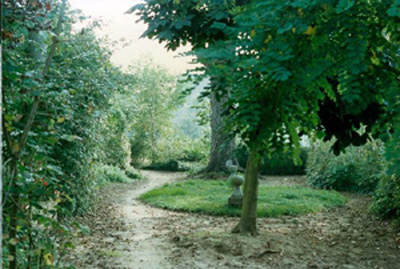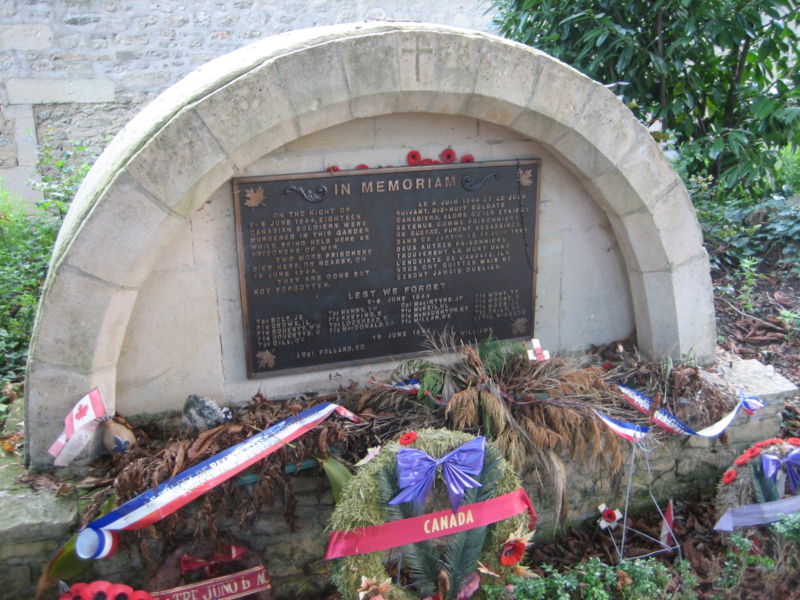
The Story of the Ardennes Abbey Massacre
8 June 1944

The 'Canadian Garden' at the restored Abbey

Memorial to the executed Canadian soldiers in the garden of the Abbey

On June 6, the Canadian soldiers fighting their way from Bernieres-sur-Mer on the coast to the assembly point at Beny-sur-Mer, included 20 young men from the North Novas, Glens, and Sherbrookes (27 CAR). Their axis of advance followed the road south and west to Carpiquet and the Caen airport. But by the end of the first day, they had only reached Anisy and the CO ordered them to dig-in, rather than push forward at full speed. Morale was high and everyone expected to meet their objective next day.
At dawn they moved forward. Early in the day, McKeil was wounded and left to be evacuated. Just after noon, Windsor's tank was hit and his crew, Philip, Bolt and Lockhead, bailed out and hid in a ditch for three hours. In the battle for Buron, Mont received shrapnel in his arm, and was ordered to return behind lines. He was captured while he waited for a pal to pick him up in his carrier. At Authie, the North Novas ran into a storm of tank and mortar fire, and many men were killed. MacIntyre, Crowe, Doucette and Moore were captured as the German SS retook the town. The Germans then swung round to encircle A Company. Defence was impossible and while a few escaped, most were killed. Millar, Moss, Doherty, MacDonald and McNaughton were taken prisoner. Keeping was captured at Buron.
The Canadians were now stretched out along their axis of advance with little protection on their left flank. The Sherbrookes moved in to cover the beleaguered North Novas, but both were forced to drop back to the defensive line established by the Glens and Highland Light Infantry at Les Buissons. Their losses were heavy. Gill and Henry were unable to escape the German advance. As evening drew in, McKeil and Mont were picked up by the Germans.


One of the Canadian soldiers executed at the Abbaye d'Ardenne
Nobody expects a war to be bloodless and hundreds
died on D-Day; but, there are rules governing how soldiers may act
towards prisoners-of-war. Despite the gruesome activities of the day, one is supposed to calmly
disarm the enemy and escort him to a place of relative safety. At Authie,
37 Canadians died, 23 of whom were killed after being disarmed. The
teenage SS soldiers in control of the town, refused to allow the French
civilian population to drag the bodies away for burial and the Canadian
dead lay in the street to be mutilated by passing tanks and military
vehicles.
More common, the prisoners were searched for weapons and rations. On June 7, the Germans then shot a number of their prisoners and marched the others back to Abbaye d'Ardenne for questioning. Some 200 made it to the German headquarters alive. Ten were separated out on June 7, never to be seen again. Seven more prisoners arrived. By then, Meyer was exhausted and tense over his losses. His soldiers were short of rations and he responded to the news of seven more Canadians with anger: "What should we do with these prisoners? They only eat our rations. In future, no more prisoners are to be taken." (Proceedings 301, quoted in Campbell: 110). The seven Canadian prisoners were taken one by one into a courtyard and shot in the back of the head by an SS corporal.

German soldiers at the Abbaye d'Ardennes
Williams and Pollard were taken after being wounded on patrol the night of June 16/17. They were the first POWs caught by the 25th Panzer Grenadier Regiment since June 8. They were questioned that same morning, then shot.

Elements of the Regina Rifle Regiment, supported by 'C' squadron of the 1st Hussars liberated the abbey after an intense, bloody battle the following month, at which time evidence of the atrocity was discovered. The bodies of these 20 men were found in 5 shallow graves between September 1944 and May 1945. None of these graves were marked, as was normal procedure. They were reburied in the cemeteries at Beny-sur-Mer, Bretteville-sur-Laize, and Ryes British Military Cemetery.
The reports of atrocities from escaped prisoners of war and liberated French civilians led Montgomery to order two Courts of Inquiry, while Eisenhower ordered a Standing Court of Inquiry be established under SHAEF. Investigations yielded evidence of the murder of about 100 Americans captured by 1st Panzer Division near Malmedy, and of a total of 134 Canadians murdered within the first 10 days of the invasion by 12th SS Panzer Division. Warrants were issued for Kurt Meyer's arrest.

Meyer had been captured by the Americans wearing a Wehrmacht uniform and had
hidden his identity for over a month before being identified. Now he was removed
to Camp Windermere in England for questioning. The facts held in evidence
against him were the remarks quoted above, as revealed by a Polish deserter,
Sturmmann Jan Jesionek and corroborating statements from other German deserters
and from Canadian POWs. Six charges were brought against him (five heard at trial), and the War Measures Act was
amended to allow prosecution.
He was held to be culpable in the murders as either having counselled them or neglected to act against the perpetrators, thereby inherently acquiescing in the atrocity. He was strip searched with meticulous care and brought to trial at the barracks in Aurich, Germany. Meyer denied reports that he told his troops to take no prisoners and evidence was produced that German soldiers from other outfits, also reputed to have committed atrocities, were in the area. No eye-witnesses were produced. Meyer defended himself by saying that the murders may have been committed in retaliation for the murder of German troops, but his account was dismissed.
Kurt Meyer in the dock
He claimed that the murders occurred under the command of Schumann and that he had punished Schumann by sending him back to the front. No-one was convinced. Meyer was found guilty of inciting his troops to deny quarter and of responsibility in the murder of 18 men. He was condemned to death subject to confirmation by Major-General Vokes who summed up: " To me . . . he was and is merely a German, and quite beyond personal sympathy." Orders for the execution were classified as secret and hurried along. Meyer was to receive an unmarked grave.
Chief Prosecutor Lieutenant-Colonel Macdonald then set in motion arrangements for a final review by the Theatre Commander, in this case, Lieutenant General Simonds, who was in the Netherlands. The Judge Advocate insisted the Theatre Commander should be by law, the senior officer "in theatre", Vokes. Simonds wanted nothing to do with it. Meanwhile, Vokes had reconsidered the death penalty and now believed that the crimes did not warrant it, Meyer's responsibility had been vicarious. His sentence was commuted to life imprisonment, to the outrage of many Canadians.
Louise Long, Ontario Provincial Secretary of the Ladies Auxiliaries of the
Canadian Legion:
"the man should hang."
Kurt Meyer on trial in Aurich, Germany before a Canadian military court
The media speculated on whether Meyer would be released within 20 years and be allowed to get a job. In the end, Meyer spent 6 years in Canadian jails, and was then transferred to Germany as the Cold War heated up. There, he was allowed to visit his family at home, to the renewed disgust of Canadians.
In 1953, a review of the severity of sentencing of war criminals, led Meyer's sentence to be reduced to 14 years, with time off for good behaviour. Since he had been a model prisoner, he was released on September 7, 1954, and became a beer salesman and leading light in the Waffen veterans' organisation. Meyer died of a heart attack on December 23, 1961, age 51.
Source: http://www.valourandhorror.com - The Canadian World War II Learning Network Website